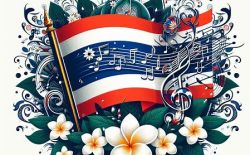National anthem of Thailand
National anthem of Thailand
The national anthem of Thailand is called Phleng Chat Thai, which means “Thai National Anthem” in Thai. It was adopted in its current form on 10 December 1939, after the country’s name was changed from Siam to Thailand. It replaced Sansoen Phra Barami, which is still used as the royal anthem of Thailand. The melody was composed by Phra Chenduriyang, and the lyrics were written by Luang Saranupraphan. The anthem praises Thailand’s independence and unity, and expresses the loyalty and devotion of the Thai people to their nation. The anthem is played twice daily, at 8am and 6pm, along with the raising and lowering of the Thai flag. Here are the lyrics of the anthem in both Thai and English:
ประเทศไทยรวมเลือดเนื้อชาติเชื้อไทย เป็นประชารัฐ ไผทของไทยทุกส่วน อยู่ดำรงคงไว้ได้ทั้งมวล ด้วยไทยล้วนหมาย รักสามัคคี ไทยนี้รักสงบ แต่ถึงรบไม่ขลาด เอกราชจะไม่ให้ใครข่มขี่ สละเลือดทุกหยาดเป็นชาติพลี เถลิงประเทศชาติไทยทวี มีชัย ชัยชน
Thailand unites flesh and blood of Thais. Nation of the people; belonging to the Thais in every respect. Long maintained [has been] the independence Because the Thais seek, and love, unity. Thais are peace-loving, But at war we're no cowards. Sovereignty will not be threatened Sacrificing every drop of blood for the nation Hail the nation of Thailand, long last the victory, Chai Yo (cheers).
What is the history of Thailand?
The history of Thailand is rich and complex, spanning from ancient times to the present day. Thailand is located in the center of mainland Southeast Asia, and has two broad geographic areas: a larger, main section in the north and a smaller, peninsular extension in the south. Thailand was never colonized by European powers, and has maintained its independence and sovereignty throughout its history
The earliest inhabitants of Thailand were the Tai-speaking peoples, who migrated from northern Vietnam into the region over a period of centuries. They established various states and kingdoms, such as Ngoenyang, Sukhothai, Lan Na, and Ayutthaya, that interacted and competed with each other and with neighboring powers, such as the Khmer Empire, Burma, and Vietnam. The Thai culture and identity emerged from the fusion of diverse influences, such as Buddhism, Hinduism, Mon, Khmer, and Chinese
The most prominent and influential kingdom in Thai history was Ayutthaya, which lasted from 1351 to 1767. Ayutthaya was a prosperous and powerful state that engaged in trade and diplomacy with many countries, such as China, India, Japan, Portugal, France, and England. Ayutthaya also faced many wars and invasions, especially from Burma, which eventually sacked and destroyed the capital in 1767
After the fall of Ayutthaya, a general named Taksin reunited the Thai people and established a new capital at Thonburi. He was succeeded by Rama I, the founder of the Chakri dynasty, which still rules Thailand today. Rama I moved the capital across the river to Bangkok, and initiated a period of cultural revival and reform. The Chakri kings also faced the challenge of modernization and westernization, as they had to deal with the colonial ambitions of the British and the French in Southeast Asia. King Chulalongkorn (Rama V) is widely regarded as the greatest modernizer of Thailand, as he introduced many social, political, and economic reforms that preserved the country’s independence and sovereignty
In 1932, a group of young military officers and civilians staged a bloodless coup that ended the absolute monarchy and established a constitutional monarchy in Thailand. Since then, Thailand has experienced many changes and upheavals, such as the Japanese occupation during World War II, the Cold War, the Vietnam War, the rapid economic development, the democracy movement, the military coups, the constitutional crises, the royal succession, and the social and political conflicts. Despite these challenges, Thailand has remained a stable and resilient nation, with a vibrant and diverse culture, a dynamic and growing economy, and a strong and revered monarchy
Who is the founder of the Thai national anthem?
The founder of the Thai national anthem is Luang Saranupraphan, who wrote the lyrics in 1939, after the country’s name was changed from Siam to Thailand. The melody was composed by Phra Chenduriyang, who was the son of a German-American musician and the royal music advisor to the Thai court. He created the tune in 1932, inspired by the No.1 Symphony by Brahms. The anthem praises Thailand’s independence and unity, and expresses the loyalty and devotion of the Thai people to their nation








